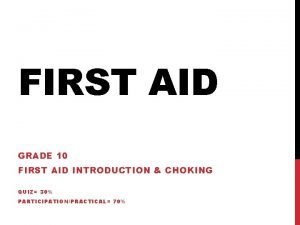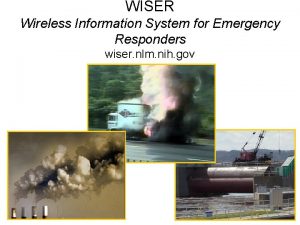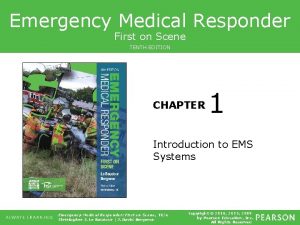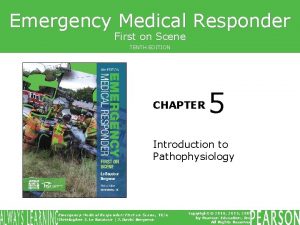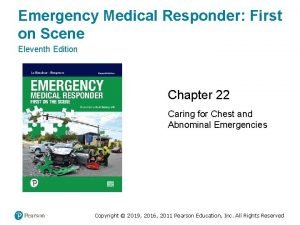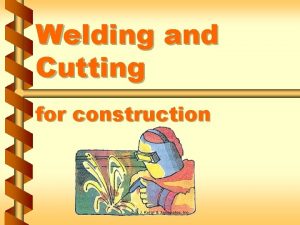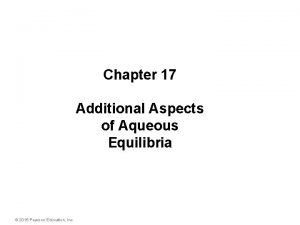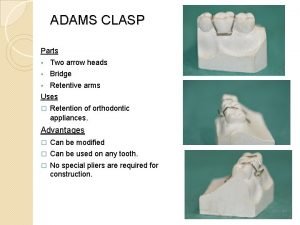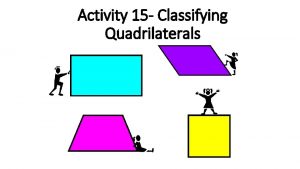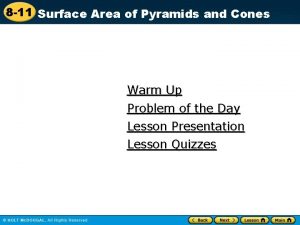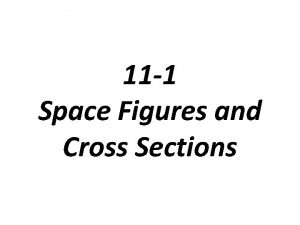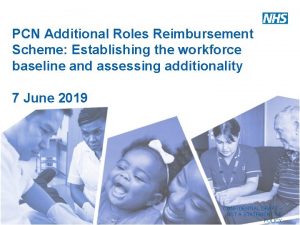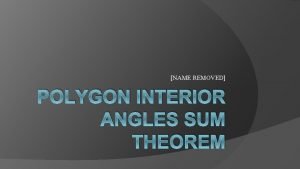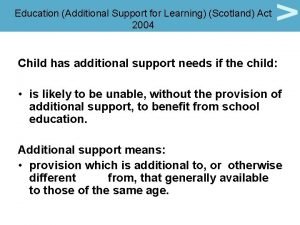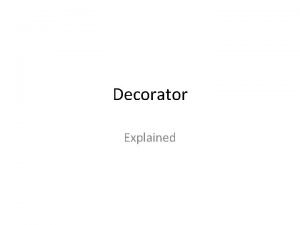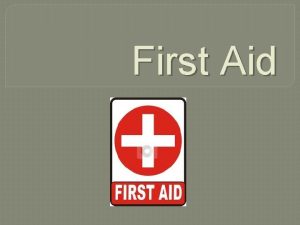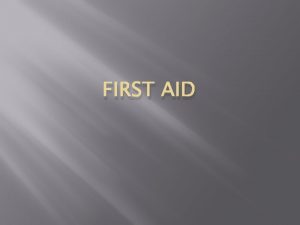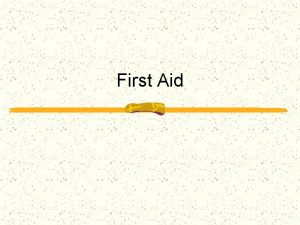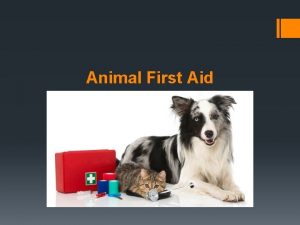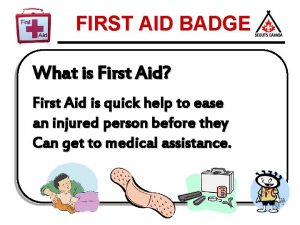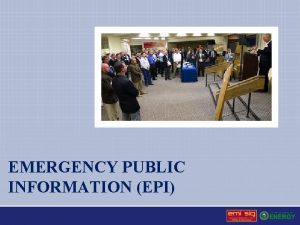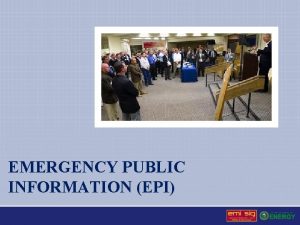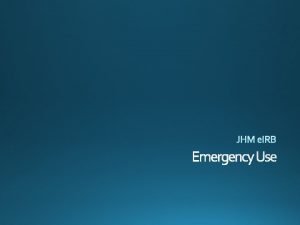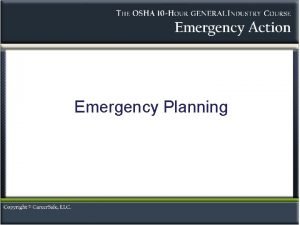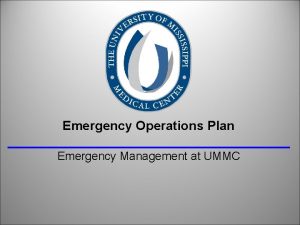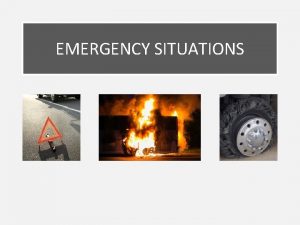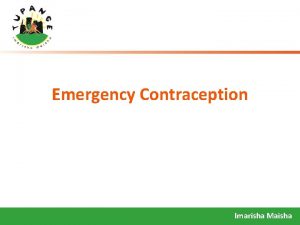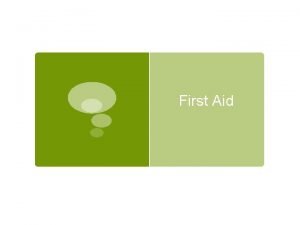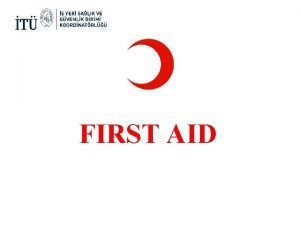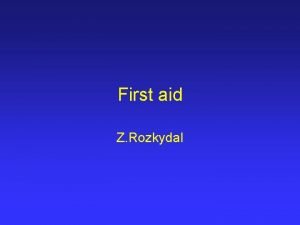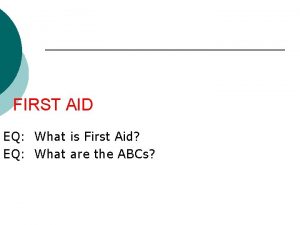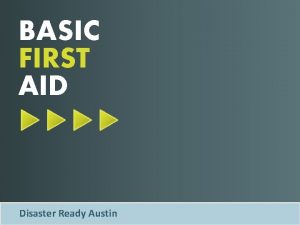First Aid Additional Information EMERGENCY FIRST AID If



























- Slides: 27

First Aid Additional Information

EMERGENCY FIRST AID íIf you are the first on the scene of accident that results in an injury or serious illness, you may be the only link between a victim and emergency medical care. Your role is to take action, whether by providing first aid, seeking medical help or calling 911. Your actions may improve the victims chance of recovery. íThe following slides will provide specific information from the American Heart Association on basic first aid procedures.

CHECK, CALL, CARE • Check: Consider safety first and make sure the surroundings are safe for you and victim. (Gloves, glasses, masks, etc. ) • Call: Call 911 or yell for help for someone to call 911. • Care: Follow CAB’s.

CAB’s of First Aid • C – Circulation • Check for circulation at correct Artery • Adult = Carotid Artery (neck) • Child = Carotid Artery (neck) • Infant = Brachial Artery (upper arm) • A – Airway • Use Head Tilt Chin Lift method to check airway for obstructions • B – Breathing • Look, Listen, and Feel for Breathing

RESCUE BREATHING

CPR Continued : … Perform chest compressions. q 30 compressions and two breaths. : Count = 1 -2 -3 -4 -5… 30 : 80 -100 chest compressions per minute : Cycle through 5 times (2/30)

CPR continued • Hand Placement for CPR • Sternum – Breast Bone • Use of Hands • Adult = Use 2 Hands • Child = Use 1 Hand • Infant = Use 2 Fingers

AED (Automated External Defribulator) • The American Heart Association has determined that 250, 000 people die each year from cardiac arrest. Ventricular fibrillation (VF) is the most common arrhythmia that causes cardiac arrest. Defibrillation is the only known treatment for VF.

MORE ON AED’s • Due to the introduction of a new generation of defibrillators, called automated external defibrillators (AED's), it is possible for lay rescuers to deliver defibrillation. The new AED's are safe, effective, lightweight, low maintenance, easy to use and relatively inexpensive (about $2000).

How Do AED's Work? • A microprocessor inside the defibrillator interprets (analyzes) the victim's heart rhythm through adhesive electrodes (some AED models require you to press an ANALYZE button). The computer analyzes the heart rhythm and advises the operator whether a shock is needed. AEDs advise a shock only to ventricular fibrillation and fast ventricular tachycardia. The electric current is delivered through the victim's chest wall through adhesive electrode pads.

BLEEDING ÜApply direct pressure to the wound (at this time a direct pressure bandage may be used) ÜElevate (do not further harm) ÜPressure Point additional pressure may be applied to a pressure point to help reduce bleeding.

2 TYPES OF WOUNDS • 1. OPEN WOUND An open wound (as in a knife cut) is a break in the skin or mucous membrane. • 2. CLOSED WOUND A closed wound (a contusion or internal bleeding) is a bruise that damages the underlying tissue without breaking the skin (as in a black eye).

CLASSIFICATION OF WOUNDS • Name Description • Avulsion (OPEN) In an avulsion, a portion of skin is torn. This can be partial, with a portion of skin remaining as a "flap. " In a total avulsion, a body part is completely torn off. • Contusion/Bruise (CLOSED) Bleeding that occurs under the skin causes discoloration, swelling. The area begins as red but may turn into a "black and blue mark. " • Incision (OPEN) A cut is a split in the skin caused by a sharp object, such as a knife, or even a dull object; has a smooth edge. • Laceration (OPEN) A cut that has a jagged edge. • Puncture (OPEN) A puncture wound is caused when the skin is pierced by a sharp object. Included in this category are gunshot wounds, impaled objects, and an object that passes totally through a part of the body. • Abrasion/Scrape (OPEN) A scrape is very common, and occurs when skin is rubbed or scraped away.

Incision Avulsion Laceration Puncture TYPES OF WOUNDS Contusion Abrasion

CARE FOR SHOCK · Keep the victim laying down (if possible). · Elevate legs 10 -12 inches… unless you suspect a spinal injury or broken bones. · Cover the victim to maintain body temperature. · Provide the victim with plenty of fresh air. · If victim begins to vomit - place them on their left side. · Call 911.

FIRST AID FOR SPRAINS AND STRAINS R-I-C-E §R-est, no activity §I-ce, for 20 minutes §C - Compress, use an elastic or conforming wrap - not too tight. §E - Elevate, above heart level to control internal bleeding.

Connective Tissue • Ligaments • Connective tissue that holds Bone to Bone • Tendons • Tissues that hold Muscle to Bone • Cartilage • Spongy padding in between joints of a Bone

TYPES OF FRACTURES

SIMPLE FRACTURE • When there is a clean break or crack in the bone, it is also known as a simple fracture.

COMPOUND FRACTURE • A compound fracture is a break in the bone with an external wound extending to the bone.

GREENSTICK FRACTURE • A split in a young, immature bone (common in children).

COMMINUTED FRACTURE • This type of fracture produces multiple bone fragments.

IMPACTED FRACTURE • An impacted fracture is one whose ends are driven into each other. This is commonly seen in arm fractures in children and is sometimes known as a buckle fracture.

Degree of Burn Epidermis Dermis First Degree Burn Hypodermis Second Degree Burn Third Degree Burn

First-Degree Burn Redness (Erythema) First Degree Burn Epidermis Dermis Hypodermis Damage to the outer layer of skin (epidermis), causing pain, redness, and swelling.

Second-Degree Burn Second Degree Burn Damage to both outer skin and underlying tissue layers (epidermis and dermis), causing pain, redness, swelling, and blistering. Blisters (Bulla)

Third-Degree Burn Full thickness burn with tissue damage Third Degree Burn Damage extends deeper into tissues (epidermis, and hypodermis) causing extensive tissue destruction. The skin may feel numb.
 First aid merit badge first aid kit
First aid merit badge first aid kit Injuries first aid
Injuries first aid Emergency care first aid and disasters
Emergency care first aid and disasters Business letter requesting information
Business letter requesting information Objectives of first aid
Objectives of first aid Wireless information system for emergency responders
Wireless information system for emergency responders Emergency managers weather information network
Emergency managers weather information network St andrew medical centre
St andrew medical centre Emergency medical responder 10th edition
Emergency medical responder 10th edition Emergency medical responder first on scene 10th edition
Emergency medical responder first on scene 10th edition Emergency medical responder first on scene 11th edition
Emergency medical responder first on scene 11th edition Fire watchers are additional personnel
Fire watchers are additional personnel Unit 12 additional needs
Unit 12 additional needs Presenting yourself on the uc application
Presenting yourself on the uc application Askov dental health education
Askov dental health education Ipo chart
Ipo chart Additional aspects of aqueous equilibria
Additional aspects of aqueous equilibria Additional aspects of aqueous equilibria
Additional aspects of aqueous equilibria 10-5 additional practice secant lines and segments
10-5 additional practice secant lines and segments Modifications of adams clasp
Modifications of adams clasp Additional practice 15-2 classify shapes
Additional practice 15-2 classify shapes Formula for surface area of pyramids
Formula for surface area of pyramids 11-1 space figures and cross sections answer key
11-1 space figures and cross sections answer key Additional roles reimbursement scheme
Additional roles reimbursement scheme Polygon interior angle sum theorem
Polygon interior angle sum theorem Askov in public health dentistry
Askov in public health dentistry Additional support for learning act 2004
Additional support for learning act 2004 Attach additional responsibilities to an object dynamically
Attach additional responsibilities to an object dynamically




